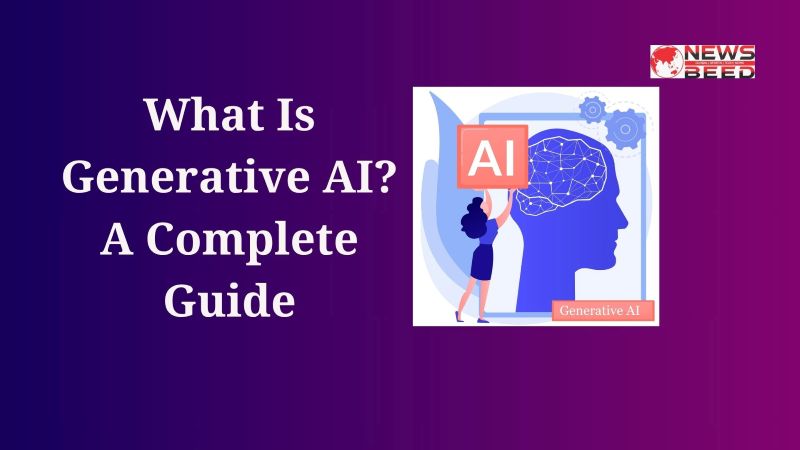Today’s era is digital and technology is progressing so fast that now AI i.e. Artificial Intelligence has also started thinking and doing creative work like humans. Especially Generative AI, which not only answers questions but can also create new music, videos and text on its own. This may sound a bit magical, but this is the truth.
Let us understand in detail what Generative AI is, how it is different from normal AI, what is the technology behind it, and most importantly—how beneficial it can be for you and what things you should keep in mind.
What is Generative AI?
Generative AI is a type of artificial intelligence that is trained on large amounts of data (such as books, music, photos) so that it can learn from that data and create something new and original.
That is, it not only remembers the information, but also has the ability to create new things in it—like an artist, writer or musician does.
Generative AI vs. Normal AI: What is the difference?
Understand it with the example of two students of a school:
Normal AI: It is like a student who memorizes everything for the exam. Whatever question you ask it, it will give you the correct information from the memorized answer. Like Google Search or Amazon’s Alexa.
Generative AI: It is like a student who not only understands the subject, but can create a new essay, a new poem or a new painting using that knowledge. It does not just memorize, but creates.
This AI technology is mainly being used in three fields:
Music
Video
Text (Text – Article, Story, Poem etc.)
AI music creation process – artificial intelligence composing modern background music automatically | AI technology to create music
How AI Creates Music
AI is played recordings of millions of songs. It does not just listen to the songs, but analyzes every aspect of them, such as:
Notes: Which notes have been used?
Rhythm: What is the tempo of the song?
Melody: What is the main melody of the song?
Mood: Is the song happy, sad, or calm?
Based on all this information, it learns the patterns of the music.
Technology
RNN (Recurrent Neural Networks) and LSTM (Long Short-Term Memory):
These models remember the sequence of notes in music over time. In simple language, they ensure that the flow of the music is maintained and it does not sound discordant.
GANs (Generative Adversarial Networks):
This is the most interesting technology. In this, two AI networks compete against each other:
The Generator (Artist): It tries to create a new music.
The Discriminator (Critic): It checks whether the music created sounds real or fake.
When the “artist” tries to deceive the “critic” again and again, the quality of the music automatically improves.
Example
If you type “happy upbeat corporate background music” on a music app like AIVA or Soundraw, the AI will understand the meaning of these words and create a new and fresh music on its own, which will be completely original.
Where is it used?
Background music for YouTube videos and podcasts.
Ads and jingles.
Emotional soundtracks in mobile games.
Personal projects like wedding videos, slideshows or presentations.
For inspiration of new music for artists.
Text-to-video AI generation – artificial intelligence creating video scenes, avatars from script input | Generative AI in video creation
How AI Creates Video
How does it work?
AI is taught by analyzing millions of videos and photos. It learns which words are associated with which visuals. When you give it commands (like “a dog is playing in the park”), it understands the text, collects the visuals associated with it, and turns them into a video.
Technology
Text-to-video Generation:
It reads your script or commands and creates visual scenes.
GAN and 3D Modeling:
Creating realistic faces (avatars), voices, and gestures.
Lip Sync:
The AI moves the character’s lips according to the voice-over in the video so that the video looks real.
Example
You write a script on a website like Synthesia, HeyGen, or Canva, choose an AI avatar, and in a matter of minutes you have a professional-looking video of that avatar speaking your script.
Where is it used?
Marketing videos and product demos.
Short clips and reels for social media.
Educational videos explaining complex topics.
Corporate presentations and training videos for employees.
AI writing content – artificial intelligence generating articles, blogs, stories from user prompt | AI in text writing
How does AI write text?
This is the most popular form of Generative AI. AI is taught almost all the text on the Internet (books, Wikipedia, blogs, news). In this process, it learns grammar, writing style, information about different subjects and the relationship between words.
When you ask it a question or ask it to write something, it thinks of the next most likely word or sentence based on the words you have given (prompt), and in this way prepares a complete article or answer.
Technology
Transformer Models:
This is a revolutionary architecture that helps AI understand the context of an entire sentence, not just the words around it.
GPT (Generative Pre-trained Transformer):
This is the most famous model, created by OpenAI and used in tools like ChatGPT.
Example
Blog posts and articles.
Captions and posts for social media.
Poems, stories and scripts.
Resumes and cover letters for jobs.
Informative essays on any topic.
Content Type
Prompt / Input (your command)
AI Output Example (AI created content)
Music
Calm meditation background music with flute and nature sounds
New peaceful music with flute and nature sounds
Video
A happy family at the park, children playing football
Video of a happy family at the park, children playing football
Text
10 Lines on Diwali in Hindi
Simple and precise 10 lines about Diwali
Benefits for Humans
Time savings: Work that used to take hours or days (like video editing or writing articles) can now be done in minutes.
Money savings: There is less need to hire expensive artists, writers or video editors for small business or personal projects.
Boundless creativity: You can try countless ideas instantly without any cost. If you don’t like one music, make another one!
Language barrier eliminated: You can create and translate content in any language.
Easy to learn: You can create professional-quality content without any technical skills.
An important question: Will AI take our jobs?
This is a big fear, especially for creative people. The answer is – no, it will not take jobs, but it will change the way jobs are done.
Think of AI as a “co-pilot” that makes your work easier and faster.
A writer can do research faster with the help of AI.
A musician can get inspiration for a new tune from AI.
A video editor can get AI to create initial drafts of a video.
The final creative touch will always be a human touch. Those who learn to use this technology will stay ahead of others.
Also Read
Challenges and Ethical Concerns
(Ethical Challenges of AI: Threats, Solutions and Safe Future)
Like every powerful technology, it also has some threats and challenges:
Human Touch: Content created by AI often lacks deep emotions, experiences and nuances.
Copyright and Privacy: The data on which AI is trained is taken from somewhere. Therefore copyright is a complex issue. Always use trusted tools.
Misinformation & Deepfakes: This technology can be used to spread fake videos (Deepfakes) or misinformation, which is dangerous for society.
Bias: If AI is trained on biased data, then the content created by it can also be biased.
Conclusion:
Generative AI has brought a new revolution in the world of technology. This is not magic, but the result of years of hard work and smart algorithms. This technology gives everyone the power to become a creator.
In the future, this technology will become even smarter, cheaper and easier, which will completely change the way of studying, entertainment and business. If you are new to technology, then do not be afraid. With a little effort, you too can create your own music, videos and articles with the help of AI and make a special identity for yourself in the digital world!




